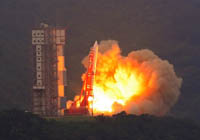Imagine the Universe News - 11 July 2005
Japan Launches World-Class Space Observatory With NASA Instruments
| 11 July 2005 |
A pioneering X-ray detector developed at NASA Goddard Space Flight Center in Greenbelt, Md., successfully launched aboard a major new Japanese space observatory on Sunday, July 10, at 12:30 p.m. local time (July 9 at 11:30 p.m. EDT) from Uchinoura Space Center in southern Japan.
Known as Astro-E2 during its development, the satellite was renamed Suzaku upon achieving orbit. Suzaku is a Japanese word for a divine bird in Chinese mythology symbolizing renewal.
The highly anticipated Suzaku mission complements NASA's Chandra X-ray Observatory and the European Space Agency's XMM-Newton mission in the study of exotic objects and regions in space that radiate predominantly in X-rays. Key targets include black holes, the million-degree gas from star explosions, and the optically invisible gas between stars and between galaxies, which comprises most of the ordinary mass in the Universe.
Suzaku carries three X-ray instruments that were developed at the JAXA Institute of Space and Astronautical Science (ISAS) in collaboration with U.S. scientists and other Japanese institutions. In addition, X-ray Telescopes (XRTs), developed at NASA's Goddard Space Flight Center, focus X-rays onto these detectors. The mission showcases an entirely new technology, the high-resolution X-ray Spectrometer (XRS), developed jointly by NASA Goddard and ISAS. The XRS measures the heat created by the individual X-ray photons, or light particles, it collects. Using this new technique, scientists can measure higher X-ray energies with a precision about 10 times greater than with previous X-ray sensors.
Suzaku launched on an M-V rocket and will attain a near-Earth circular orbit at approximately 560 kilometers (345 miles). First light is expected in about three weeks. The observatory's expected mission lifetime is five years. Suzaku is the fifth in a series of Japanese satellites devoted to studying celestial X-ray sources.


